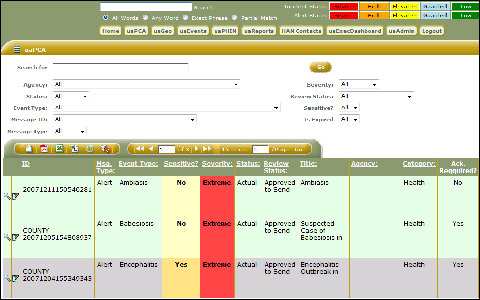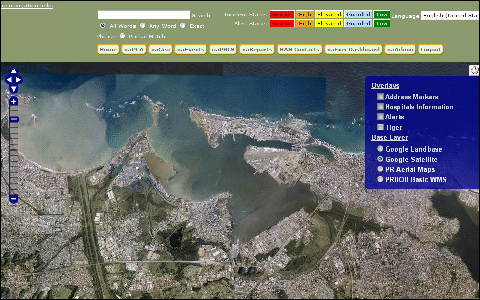| Department of Health and Human Services (HHS) |
| uaPartners Communication Alerting System |
"We saved two person years of development time using Iron Speed Designer."
- Len Bullard, VP, Research and Development of Utility Automation Integrators, Inc.
|
|
|
uaPartners Communication Alerting System |
UAI Inc.
Huntsville, AL USA
|
The uaPartners Communication Alerting System (uaPCA) was developed for the Department of Health and Human
Services (HHS) and other health partners. The application is used to issue alerts on state and local health
alert networks. Alerts must conform to the requirements of the Centers for Disease Control and Prevention (CDC)
and the OASIS Common Alerting Protocol (CAP). Details about the specific clients at this time are confidential.
This is a new application based on prior work done for a customer using our Emergency Incident Command System.
uaPCA enables the creation and publication of health alerts and notifications to health partners. This alert is
equivalent to a Reverse 911 for health systems.
 uaPCA Alert Screen
uaPCA Alert Screen
The health alert network includes the Department of Health and Human Services (HHS), health partners and
volunteers, and others. The state health agency maintains a list of diseases that require notification when
occurrences are observed. When a suspected listed disease is observed, a partner creates an event record in
the system. The record is immediately seen by the uaPCA operators. These operators may be at HHS, or at an
Emergency Operations Center during an emergency such as a natural disaster or a terrorist act involving a biological
agent. Once HHS assesses the event and creates a case, the uaPCA system issues an alert to all health partners. The
uaPCA system contains a list of registered users, with user profiles including preferred means of notification, i.e.,
cell phone, pager, fax machines, etc. The system automatically contacts the registered users and provides alert summary
information. The system also provides log-in instructions to a private Web page for more details and instructions.
|
Application size and scope |
|
The application is comprised of 100 tables across one Microsoft SQL Server database. To date, there
are 75 modules, each containing its own set of Web pages.
|
The project |
|
This application took our development team a total of six months; however, the Iron Speed Designer portion
of the project was completed in three months. We actually spent the first three months attempting to create
the project in Microsoft Visual Studio. Once we had Iron Speed Designer, we threw away the first prototypes.
Restarting and finishing the project within three months was the most impressive part of using Iron Speed Designer!
The tool actually revealed flaws in our table design and enabled us to simplify its structure. This resulted in a much
more efficient and maintainable package.
|
Code extensions and customizations |
Approximately 30,000 lines of custom code were written for this application. The major
customizations included:
 | Added language translation code into the dropdowns. |
 | Replaced language switching capability to accommodate bilingual application (English/Spanish). |
 | Implemented top-down localization. |
 | Parsed the display stream. |
 | Color-coded grids to improve use in Emergency Operations Centers.
|
We incorporated several third-party controls, including Karamasoft Search and Spell Checking and
the UAI Map viewer package.
 uaGeo Map View
uaGeo Map View
|
Page layout customizations |
We added special algorithms to parse the display stream in order to color-code table grids. Color-coding
greatly improves application use in Emergency Operations Centers. We also added a hierarchical menu to emulate
a collapsible menu for convenience.
We used the standard Denali design theme in Iron Speed Designer.
|
Iron Speed Designer impact |
We saved two person years of development time using Iron Speed Designer. This tool saved our department's ass!
The project was bid with unreasonable schedule constraints. Now, with Iron Speed Designer, we
are now actually making that schedule.
It would have taken two years to develop this project by hand. While the project itself would have
been feasible without the tool, we absolutely could not have done it within the proposed time frame!
|
Next steps |
|
We currently have plans to extend uaPCA to incorporate additional health partners and add users.
|
About the developer |
|
Len Bullard has more than 25 years of experience as a software systems developer.
He holds a B.A. in English and Music. He is an author, a working musician and composer, and
is the married father of two children.
|
|
|
|
|
|
|
